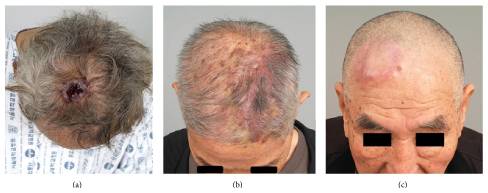|
Lymphangiosarcoma
Lymphangiosarcoma is a rare cancer which occurs in long-standing cases of primary or secondary lymphedema (swelling due to lymphatic system obstruction). It involves either the upper or lower lymphedematous extremities but is most common in upper extremities. Although its name implies lymphatic origin, it is believed to arise from endothelial cells and may be more accurately referred to as angiosarcoma. Signs and symptoms Lymphangiosarcoma may present as a purple discoloration or a tender skin nodule in the extremity, typically on the anterior surface. It progresses to an ulcer with crusting to an extensive necrotic focus involving the skin and subcutaneous tissue. It metastasizes quickly. Lymphangiosarcoma mostly occurs in the upper arm, forearm, elbow, and anterior chest wall. Furthermore, in post-mastectomy patients, lymphangiosarcoma is associated with sarcomatous degeneration, especially in patients who have survived five or more years and who have severe lymphedema. Cause ... [...More Info...] [...Related Items...] OR: [Wikipedia] [Google] [Baidu] |
Stewart–Treves Syndrome
Stewart–Treves syndrome is a lymphangiosarcoma, a rare disorder marked by the presence of an angiosarcoma (a malignant tumor of blood or lymph vessels) in a person with chronic (long-term) lymphedema. Although it most commonly refers to Malignancy, malignancies associated with chronic lymphedema resulting from mastectomy and/or radiotherapy for breast cancer, it may also describe lymphangiosarcomas that result from congenital and other causes of chronic secondary lymphedema. Lymphangiosarcoma arising from cancer-related lymphedema has become much less common with better surgical techniques, radiation therapy, and conservative treatment. The prognosis, even with wide surgical excision and subsequent radiotherapy, is poor. Signs and Symptoms Lymphangiosarcoma usually occurs many years following a mastectomy, usually between 5 and 15 years. Cutaneous angiosarcoma can begin as a "spreading bruise" or a raised purple-red papule before progressing to tissue Infiltration (medical), inf ... [...More Info...] [...Related Items...] OR: [Wikipedia] [Google] [Baidu] |
Angiosarcoma
Angiosarcoma is a rare and aggressive cancer that starts in the endothelial cells that line the walls of blood vessels or lymphatic vessels. Since they are made from Endothelium, vascular lining, they can appear anywhere and at any age, but older people are more commonly affected, and the Human skin, skin is the most affected area, with approximately 60% of cases being wikt:cutaneous, cutaneous (skin). Specifically, the scalp makes up ~50% of angiosarcoma cases, but this is still <0.1% of all head and neck tumors. Since angiosarcoma is an Hyponymy and hypernymy, umbrella term for many types of tumor that vary greatly in origin and location, many symptoms may occur, from completely asymptomatic to non-specific symptoms like Skin condition, skin lesions, Ulcer (dermatology), ulceration, shortness of breath and abdominal pain. Multiple-organ involvement at time of diagnosis is common and makes it difficult to ascertain ... [...More Info...] [...Related Items...] OR: [Wikipedia] [Google] [Baidu] |
Lymphedema
Lymphedema, also known as lymphoedema and lymphatic edema, is a condition of localized edema, swelling caused by a compromised lymphatic system. The lymphatic system functions as a critical portion of the body's immune system and returns interstitial fluid to the bloodstream. Lymphedema is most frequently a complication of cancer treatment or parasitic infections, but it can also be seen in a number of genetic disorders. Tissues with lymphedema are at high risk of infection because the lymphatic system has been compromised. Though incurable and progressive, a number of treatments may improve symptoms. This commonly includes compression therapy, good skin care, exercise, and manual lymphatic drainage (MLD), which together are known as combined decongestive therapy. Diuretics are not useful. Signs and symptoms The most common manifestation of lymphedema is soft tissue swelling (edema). As the disorder progresses, worsening edema and skin changes including discoloration, verr ... [...More Info...] [...Related Items...] OR: [Wikipedia] [Google] [Baidu] |
Lymphangioma
Lymphatic malformations are benign slow-flow type of vascular malformation of the lymphatic system characterized by lymphatic vessels which do not connect to the normal lymphatic circulation. The term ''lymphangioma'' is outdated and newer research reference the term ''lymphatic malformation''. Lymphatic malformations can be macrocystic, microcystic, or a combination of the two. Macrocystic have cysts greater than , and microcystic lymphatic malformation have cysts that are smaller than . These malformations can occur at any age and may involve any part of the body, but 90% occur in children less than 2 years of age and involve the head and neck. These malformations are either congenital or acquired. Congenital lymphangiomas are often associated with chromosomal abnormalities such as Turner syndrome, although they can also exist in isolation. Lymphangiomas are commonly diagnosed before birth using fetal ultrasonography. Acquired lymphangiomas may result from trauma, inflammat ... [...More Info...] [...Related Items...] OR: [Wikipedia] [Google] [Baidu] |
Hemangiosarcoma
Hemangiosarcoma is a rapidly growing, highly invasive variety of cancer that occurs almost exclusively in dogs, and only rarely in cats, horses, mice, or humans (vinyl chloride toxicity). It is a sarcoma arising from the lining of blood vessels; that is, blood-filled channels and spaces are commonly observed microscopically. A frequent cause of death is the rupturing of this tumor, causing the patient to rapidly bleed to death. The term "angiosarcoma", when used without a modifier, usually refers to hemangiosarcoma. However, glomangiosarcoma (8710/3) and lymphangiosarcoma (9170/3) are distinct conditions (in humans). Dogs Hemangiosarcoma is quite common in dogs, and more so in certain breeds including German Shepherds and Golden Retrievers. It also occurs in cats, but much more rarely. Dogs with hemangiosarcoma rarely show clinical signs until the tumor has become very large and has metastasized. Typically, clinical signs are due to hypovolemia after the tumor ruptures, causi ... [...More Info...] [...Related Items...] OR: [Wikipedia] [Google] [Baidu] |
Cancer
Cancer is a group of diseases involving Cell growth#Disorders, abnormal cell growth with the potential to Invasion (cancer), invade or Metastasis, spread to other parts of the body. These contrast with benign tumors, which do not spread. Possible Signs and symptoms of cancer, signs and symptoms include a lump, abnormal bleeding, prolonged cough, unexplained weight loss, and a change in defecation, bowel movements. While these symptoms may indicate cancer, they can also have other causes. List of cancer types, Over 100 types of cancers affect humans. Tobacco use is the cause of about 22% of cancer deaths. Another 10% are due to obesity, poor Diet (nutrition), diet, sedentary lifestyle, lack of physical activity or Alcohol abuse, excessive alcohol consumption. Other factors include certain infections, exposure to ionizing radiation, and environmental pollutants. infectious causes of cancer, Infection with specific viruses, bacteria and parasites is an environmental factor cau ... [...More Info...] [...Related Items...] OR: [Wikipedia] [Google] [Baidu] |
Gemcitabine
Gemcitabine, sold under the brand name Gemzar, among others, is a chemotherapy medication used to treat cancers. It is used to treat testicular cancer, breast cancer, ovarian cancer, non-small cell lung cancer, pancreatic cancer, and bladder cancer. It is administered by intravenous infusion. It acts against neoplastic growth, and it inhibits the replication of Orthohepevirus A, the causative agent of Hepatitis E, through upregulation of interferon signaling. Common side effects include bone marrow suppression, liver and kidney problems, nausea, fever, rash, shortness of breath, mouth sores, diarrhea, neuropathy, and hair loss. Use during pregnancy will likely result in fetal harm. Gemcitabine is in the nucleoside analog family of medication. It works by blocking the creation of new DNA, which results in cell death. Gemcitabine was patented in 1983 and was approved for medical use in 1995. Generic versions were introduced in Europe in 2009 and in the US in 2010. It is on ... [...More Info...] [...Related Items...] OR: [Wikipedia] [Google] [Baidu] |
Lymphatic Vessel Diseases
Lymph () is the fluid that flows through the lymphatic system, a system composed of lymph vessels (channels) and intervening lymph nodes whose function, like the venous system, is to return fluid from the tissues to be recirculated. At the origin of the fluid-return process, interstitial fluid—the fluid between the cells in all body tissues—enters the lymph capillaries. This lymphatic fluid is then transported via progressively larger lymphatic vessels through lymph nodes, where substances are removed by tissue lymphocytes and circulating lymphocytes are added to the fluid, before emptying ultimately into the right or the left subclavian vein, where it mixes with central venous blood. Because it is derived from interstitial fluid, with which blood and surrounding cells continually exchange substances, lymph undergoes continual change in composition. It is generally similar to blood plasma, which is the fluid component of blood. Lymph returns proteins and excess interstitial f ... [...More Info...] [...Related Items...] OR: [Wikipedia] [Google] [Baidu] |
Sarcoma
A sarcoma is a rare type of cancer that arises from cells of mesenchymal origin. Originating from mesenchymal cells means that sarcomas are cancers of connective tissues such as bone, cartilage, muscle, fat, or vascular tissues. Sarcomas are one of five different types of cancer, classified by the cell type from which they originate. While there are five types under this category, sarcomas are most frequently contrasted with carcinomas which are much more common. Sarcomas are quite rare, making up about 1% of all adult cancer diagnoses and 15% of childhood cancer diagnoses. There are many subtypes of sarcoma, which are classified based on the specific tissue and type of cell from which the tumor originates. Common examples of sarcoma include liposarcoma, leiomyosarcoma, and osteosarcoma. Sarcomas are ''primary'' connective tissue tumors, meaning that they arise in connective tissues. This is in contrast to ''secondary'' (or " metastatic") connective tissue tumors, ... [...More Info...] [...Related Items...] OR: [Wikipedia] [Google] [Baidu] |
Paclitaxel
Paclitaxel, sold under the brand name Taxol among others, is a chemotherapy medication used to treat ovarian cancer, esophageal cancer, breast cancer, lung cancer, Kaposi's sarcoma, cervical cancer, and pancreatic cancer. It is administered by intravenous injection. There is also an albumin-bound formulation. Common side effects include hair loss, bone marrow suppression, numbness, allergic reactions, muscle pains, and diarrhea. Other side effects include heart problems, increased risk of infection, and lung inflammation. There are concerns that use during pregnancy may cause birth defects. Paclitaxel is in the taxane family of medications. It works by interference with the normal function of microtubules during cell division. Paclitaxel was isolated in 1971 from the Pacific yew and approved for medical use in 1993. It is on the World Health Organization's List of Essential Medicines. It has been made from precursors, and through cell culture. Medical use Paclitaxel ... [...More Info...] [...Related Items...] OR: [Wikipedia] [Google] [Baidu] |
Ifosfamide
Ifosfamide, sold under the brand name Ifex among others, is a chemotherapy medication used to treat a number of types of cancer. This includes testicular cancer, soft tissue sarcoma, osteosarcoma, bladder cancer, small cell lung cancer, cervical cancer, and ovarian cancer. It is administered by injection into a vein. Common side effects include hair loss, vomiting, blood in the urine, infections, and kidney problems. Other severe side effects include bone marrow suppression and decreased level of consciousness. Use during pregnancy will likely result in harm to the baby. Ifosfamide is in the alkylating agent and nitrogen mustard family of medications. It works by disrupting the duplication of DNA and the creation of RNA. Ifosfamide was approved for medical use in the United States in 1987. It is on the World Health Organization's List of Essential Medicines. Medical uses It is given as a treatment for a variety of cancers, including: * Testicular cancer * Breas ... [...More Info...] [...Related Items...] OR: [Wikipedia] [Google] [Baidu] |



